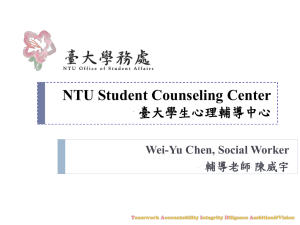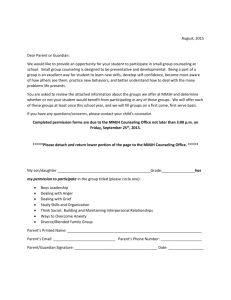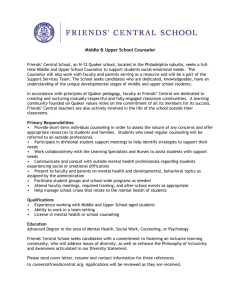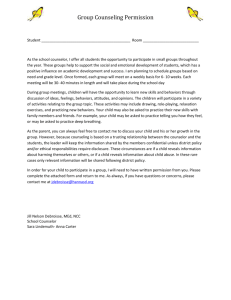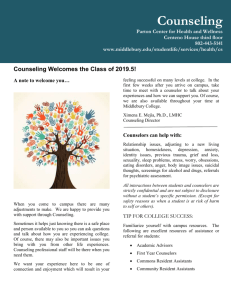A New Paradigm for teaching Counselling Theory and Practice
advertisement
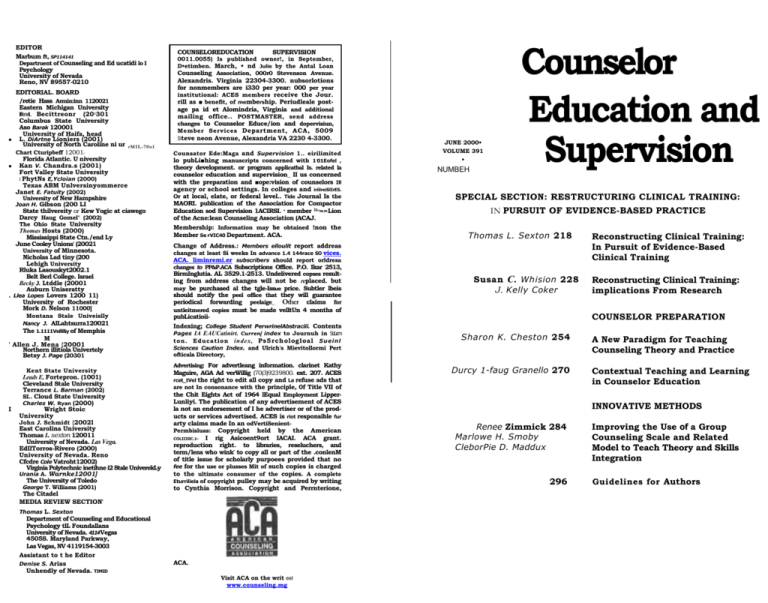
EDITOR
Marbum ft, SP114141
Departruent of Counseling and Ed ucatidi lo I
Psychology
University of Nevada
Reno, NV 89557-0210
EDITORIAL. BOARD
/retie Hass Armin:inn 1120021
Eastern Michigan University
liflrlenelL Becittreonr (20 1301
Columbus State University
Aso Barak 120001
University of Haifa, head
L. DiArtne Lioniers (2001)
University of North Caroline ni ur rM I L -7 0 n1
Chart Cturipbeff 12001)
Florida Atlantic. U niversity
Kan V. Chandra.s (2001)
Fort Valley State University
I PhytNs E,Ycloian (2000)
Texas ABM Unlversinyommerce
Janet E. Fatuity (2002)
University of New Hampshire
Joan H. Gibson (200 LI
State thilvereity or Kew Yogic at ciawego
Darcy Haug Gomel° (2002)
The Ohio State University
Thomas Hosts (2000)
Mississippi State Ctn./end Ly
June Cooley Unions' (20021
University of Minnesota.
Nicholas Lad tiny (200
Lehigh University
Rluka Lasouskyt2002.1
Belt Berl College. Israel
Becky J. Ltddle (20001
Auburn Uniseratty
. Llea Lopes Lovers 1200 11)
University of Rochester
Mork D. Nelson 11000]
Montana Stale Univeislly
Nancy J. AlLahtsurra120021
The 1.1111Vellillfy of Memphis
M
' Allen J. Mena {20001
Northern illitiola Univertely
Betsy J. Page (20301
Kent State University
I
Leads E, Fortepron. (1001)
Cleveland Stale University
Terrance L. Barman (2002)
SI.. Cloud State University
Charles W. Ryan (2000)
Wright Stoic
University
John J. Schmidt {2002l
East Carolina University
Thomas L. sexton 120011
University of Nevada. Las Vega.
EdIlTorros-Rivero (2000)
University of Nevada. Reno
Cfcdre Cole Vatroht12002)
Virginia Polytechnic inetihne i2 Stale UniverekLy
Urania A. Warnke12001]
The University of Toledo
George T. Williams (2001)
The Citadel
MEDIA REVIEW SECTION'
COUNSELOREDUCATION
SUPERVISION
0011.0055) Is published owner!, in September,
D•etimben. March, • nd Julie by the Antal Loan
Counseling Association, 000r0 Stevenson Avenue.
Alexandris. Virginia 22304-3300. nubsorlotions
for nonmembers are i330 per year: 000 per year
institutional: ACES members receive the Jour.
rill as ■ benefit, of membership. Periudleale postage pa id et Alomindria, Virginia and additional
mailing office.. POSTMASTER, send address
changes to Counselor Educe/ion and dopervisiun,
Member Services Department, ACA, 5009
Steve neon Avenue, Alexandria VA 2230 4-3300.
Counsator Ede:Maga and Supervision 1.. eirilimited
lo pubLi■hing manuscripts concerned with 1-01Eofel ,
theory development. or program applicatbal Is. related la
counselor education and supervision_ II us concerned
with the preparation and ■ope:vision of counselors Ill
agency or school settings. In colleges and iriilreiSlIrES.
Or at local, elate, or federal level.. Tide Journal Is the
MAORI. publication of the Association for Compactor
Education sod Supervision 1ACIRSI. a member 11"134-113. Lion
of the Acne:lean Counseling Association (ACAJ.
Membership: Information may be obtained !non the
Member Se rVIC40 Department. ACA.
Change of Address.: Members elloulit report addreas
changes at least Si weeks In advance 1.4 144race SO vices.
ACA. liminremi.er subscribers should report orldresa
changes to PP&P.ACA Subscriptions Office. P.O. Ikar 2513,
BirmInglutia. AL 3529.1-2513. Undelivered copses resulting from address changes will not be replaced. but
may be purchased al the tgle-Issue price. Subtler lbeis
should notify the peel office that they will guarantee
periodical forwarding peelaige_ Other claims for
untleitmered copies must be made velltUn 4 months of
pubLicatioiiIndexing; College Student PerwrinelAbstraciii. Contents
Pages IA EAUCatinirt. Curren[ index to Journuh in Sducm
ton. Education index, Ps5rchologloal Sueinl
NUMBEH
SPECIAL SECTION: RESTRUCTURING CLINICAL TRAINING:
IN PURSUIT OF EVIDENCE-BASED PRACTICE
Thomas L. Sexton 218
Susan C. Whision 228
J. Kelly Coker
Sharon K. Cheston 254
ofticala Directory,
Advertising: For advertleang information. clarinet Kathy
Maguire, AGA Ad verWillig (70(3)923-9800. ext. 207. ACES
rcet_tVel the right to edit all copy and La refuse ads that
are not In consonance with the principle, 0f Title VII of
the Chit Eights Act of 1964 lEqual Employment LipperLunliyi. The publication of any advertisement of ACES
la not an endorsement of I he advertiser or of the products or services advertised. ACES is riot responsible fur
arty claims made In an odVertiSenientPermbisluas: Copyright held by the American
COLIII0C.1I rig Asicoent9ort IACAI. ACA grant.
reproduction right. to libraries, reseluchers, and
term/lens who wink' to copy all or part of the .conlenM
of title issue for scholarly purpoees provided that no
fee for the use or plusses Mit of such copies is charged
to the ultimate consumer of the copies. A complete
Eturriliela of copyright pulley may be acquired by writing
to Cynthia Morrison. Copyright and Perrnterione,
ACA.
Visit ACA on the writ eel
www.counseling.mg
Reconstructing Clinical Training:
In Pursuit of Evidence-Based
Clinical Training
Reconstructing Clinical Training:
implications From Research
COUNSELOR PREPARATION
Sciences Caution Index. and Ulrich's Mievitollormi Pert
Thomas L. Sexton
Department of Counseling and Educational
Psychology tlL Foundallans
University of Nevada. 4114Vegas
4505S. Maryland Parkway,
Las Vegas, NV 4119154-3003
Assistant to t he Editor
Denise S. Arias
Unhendly of Nevada. TIMID
JUNE 2000•
VOLUME 391
•
Counselor
Education and
Supervision
Durcy 1-faug Granello 270
A New Paradigm for Teaching
Counseling Theory and Practice
Contextual Teaching and Learning
in Counselor Education
INNOVATIVE METHODS
Renee Zimmick 284
Marlowe H. Smoby
CleborPie D. Maddux
296
Improving the Use of a Group
Counseling Scale and Related
Model to Teach Theory and Skills
Integration
Guidelines for Authors
" .24101111-4'
'min.:011hp
•,.• •
••
■
counselor preparation
A New Paradigm for Teaching
,
Counseling Theory and
Practice
SHARON E. CHESTON
The author discusses a paradigm for understanding the myriad of counseling
theories and their corresponding intervention techniques, The paradigm Drga•
nixes counseling theory and practice around three principles: a way of being, a
way of undersianding, and a way of inieruening. The paradigm assists counselors In sorting out the similarities and differences between the counseling theories and allows them to eclectically use various theories and techniques without
losing the consistency and cohesiveness of working within a structure.
The integration of counseling theories into an eclectic approach is
an important trend in the field of counseling (Arkowitz, 1992;
Bradley. Parr. & Gould, 1995; Kelly, 1997). Most counselors tend
to embrace an eclectic stance in their practice with an average of
4.4 theories making up their therapeutic work with clients
(Garfield & Bergin, 1994; Jensen, Bergin, & Creaves. 1990). One
author has conservatively estimated that over 240 counseling
theories have been espoused since the development of Freudian
theory (Corsini, 1981). How to integrate the various theories to best
serve their clients is a major hurdle for counselors and counselor
educators (Ginter, 1988). All theories and their corresponding
practices assist clients in changing to meet their personal goals.
However, each of these theories' proponents claim that their
position is the most efficacious. The psychodynamic theorists
claim dominance in the area of understanding the intricacies of
human development and functions. The cognitive—behaviorists
propose their theories' intervention styles as most effective,
The humanist/ experientialists assert their theories'
prominence In the area of
Sharon E. Clwstan is afull professor in the Department of Pastoral Counseling at
Loyola College of Maryland in Baltimore. Correspondence regarding !his oriole
shoutd be sent to Sharon B. Ches4on, 208 Donusoit Oriue, Cockeysville,. MD 21030
fe-mait: schesion@loyola.edul.
25-4
COUNSELOR. EDUCATION AND SUPERVIStON / JUNE '2000 / VOL. 30
the therapeutic relationship, while family theorists proffer the
essential elements of system intervention. Can all be correct at
the same time? The answer is a resounding "Yes!" If Rogers was
;-iceurate that advances in the field of counseling will eventually
cause the "demise of 'schools` of psychotherapy, including this
one [client centeredr (Rogers, 1961 p. 268), then eclecticism will
become the 'theory" of choice.
One positive aspect of eclecticism is its ability to draw on various theories, techniques, and practices to meet clients' needs.
Thus, counselors embrace eclecticism because they are aware that
no one theory works for every client (Corey, 1996). "Increasingly
therapists no longer ask 'Which is the best therapy?' but 'What is
the best therapy for a specific type of client?' (Shalt 1996, p. 10).
The limitations of eclecticism are lack of structure and of informed knowledge about how to choose wisely what theory or technique to engage with which client (Bradley et al.. 1995). MacDonald
(1991) asserts, "Mental health counselors face an explosion of
counseling models. Unless counselors understand the philosophical
systems that undergird these models of counseling, plus the implications of those philosophical systems for actions in counseling they risk using counseling models inappropriately or
inefficiently' (p. 379). Counselors who work eclectically can risk
becoming technicians who prescribe or assist change without
understanding the root of the dysfunction and without grounding
their understanding with a sense of why they select certain tools
to use with certain clients, at certain times, and in certain ways
(Kottler & Brown. 1992; Patterson, 1986a). Theory assists professionals in this grounding. To maximize eclecticism's strengths and
minimize its limitations, eclecticism needs a paradigm to help
structure theoretical knowledge and intervention strategies.
Corey (1996) encourages readers to develop an integrated approach to their counseling practices but does not indicate how to
accomplish this integration. Likewise, Corsini states in his introductory chapter '1 would go even further and state that GIB good
therapists are eclectic" (Corsini & Wedding, 1989, p. 9). He asserts that to be eclectic one needs to know many different theories and systems so that a personal counseling structure can
develop. However, he also states that the development of a personal, integrated approach to counseling takes many years. Therefore, he encourages neophyte counselors to operate within one
theoretical system while developing their own styles or approaches
(Corslnl & Wedding, 1989).
New counselors can begin to integrate theory if they have a
paradigm that will assist them in this integration as they Learn
the many theories and begin the development of their own personal
4
4
COUNSELOR EDUCATION AND SU PERvisioN / JUNE 2040 / VOL. 79
255
approach to counseling, As the initial pedagogues who teach counseling theory and the corresponding techniques to students, counselor educators face the struggle of how to give new student
counselors a broad sweep of the richness of various theories and
their Corresponding practices without overwhelming them,
Searching for an answer led to the development of a new paradigm
that helps master's and doctoral students organize the major theories
into a conceptual framework and reduces their confusion and
feelings of being overwhelmed by the various theories and their
concepts.
Currently. counseling theory and practice is organized and taught
by introducing students to many theories (Capozzi & Gross. 1995:
Corey, 1996: Corsini & Wedding. 1989: Sharf, 1996), Most writers of
textbooks organize the material around several topics such as history, major concepts, intervention strategies, process of change, and
personality theory. All of these topics are essential to understanding
theories, However, when students begin to practice counseling they
can become bewildered by the concepts generated from the theories.
The ways paraf,liglin helps to organize these theoretical concepts.
THE WAYS PARADIGM
The ways paradigm proposes that the subject of counseling theory
and practice can be organized around three principles: a way of
being, a way of understanding, and a way of intervening. Every
major theory addresses the above three ways in proposing how a
theory is helpful to counselors in working with clients.
The three ways help students understand many theories by
using a paradigm that can be overlaid on any theory and can
quickly assist the rn in selecting a theory that might work with a
particular client, The ways also aid students in shifting between
theories with a better understanding of and sensitivity to the
reasons for selecting one theory over another.
A Way of Being
A way of being addresses the counselor's presence in the room
with the client. Who the counselor is, the degree of empathy expressed, the values the counselor demonstrates, the boundaries
that are set, and the Importance ascribed to the relationship are
all part of a way of being. In other words, each theory proposes
how the counselor should be with a client to establish an atmosphere in which change can occur.
A Way of Understanding
A way of understanding involves the body of counseling knowledge that explains personality theory and structure, normal and
25.11
COLINSEISNI. D 11 CAT! 0 AN13 SUPERVISION /JUNE 20017 ./ VOL. ZSSII
abnormal human development, and different ways people change.
This area includes understanding levels of the unconscious and
conscious, human behavior, and formation of belief systems. In addition, identifying the ways individuals assimilate culture, think about
themselves, interact with others, in troject family values. develop symptoms of psychopathology, emote, and behave are instrumental In
understanding humans. Away of understanding also involves knowledge of clients' strengths, resources, and existing skills.
A Way of Intervening
The way of Intervening is the 'work" of therapy. Theories not only
help to explain how change occurs but what technique will enhance a client's movement toward the goal of increased mental
health, In other words, a way of Intervening refers to the means
by which a counselor interrupts the client's cycle of dysfunction
and allows for the processing of healthier alternatives of thinking,
feeling, and behaving. To intervene effectively counselors develop
a treatment plan with the client outlining the desired goals. Once
the goals are formulated, the counselor draws from knowledge of
and relationship with the client to challenge, interpret, reflect,
and support the client toward the therapeutic goals. The job Is to
assist the client by structuring the change process and using
counseling knowledge to Implement steps toward the goal. The
counseling process then becomes one of practicing, reviewing,
repeating, and affirming the desired changes. Interventions can
also include refraining feelings, changing attitudes, altering belief
systems, gaining insight, grieving, or staying with painful feelings
in the presence of another supportive person.
Case Study
A student counselor was seeing a female client who had been diagnosed with recurrent major depression. The student had been
taught that the standard treatment for depression was a combination of appropriate medication and cognitive-behavioral therapy.
The student referred the client to a psychiatrist for medication
evaluation, and the client was placed on an antidepressant, The
student then read additional materials about Rational emotive
Behavioral Therapy (REBT; Ellis & Dryden. 1987: Hollon & Beek,
1994) and began using its principles, lie had expertly defined the
client's cognitive distortions and negative self-messages and began working with these concepts with her. The REBT teaching/
mentoring way of being was apparent in his session tapes. However, within a few sessions the client began to act out with the
student by arriving late, skipping appointments, and sitting quietly with her arms folded during the session. The student was
COIJIN5E (nit EDUCA114)14 AND SUPERVISION / JUNE 200Q /
9
IS57
baffled by the behavior because, he reasoned, he was intervening
in the appropriate, standard treatment manner. After he learned
the three ways, he was able to look at his way of being as being
congruent with REST but possibly incongruent with what the client needed. After he reviewed different ways of being from several
theories, he selected person-centered theory (Rogers, 1980) because the concepts of unconditional positive regard and genuineness matched the client's expressed need for support during her
depression. Within two sessions, the client was sharing openly
and exploring distortions in her thinking. Thus, the student was
able to combine theories while still working within a cohesive
paradigm. He was able to shift his way of being with the client
while still using REBT's ways of understanding and intervening.
The above example is an illustration of switching ways of being
without becoming lost in the maze of theoretical assumptions.
The same type of switch can be generated in a way of understanding and a way of intervening.
Space limitation prohibits the discussion of all major theories'
ways, therefore discussion is organized around four major approaches to counseling: psychodynamic, humanistic/experiential.
cognitive-behavioral, and family systems. Individual theories will
be discussed briefly within the context of these approaches.
Assigning theories to broader categories has been discussed in
several counseling theory and practice textbooks (Capozzi & Gross.
1995: Corey, 1996; Corsini & Wedding, 1989; Shari, 1996). Although some writers refer to the psychodynamic approach as dynamic or analytic (Corey, 1996; Sharf, 1996), most agree on the
category titles of humanistic/experiential, cognitive-behavioral, and
family systems. In general, most editors categorize psychoanalysis, AdIerian, Jungian, and the neopsychoanalyses (self, ego. and
object relations) as psychodynamic, dynamic, or analytic {Capozzi
& Gross, 1995: Corey. 1996; Corsini & Wedding, 1989: Shari, 19961.
In the same vein, writers refer to the category humanistic/experiential as containing existential, person-centered, and gestalt
theories (Capozzi & Gross. 1995: Corey, 1996: Corsini & Wedding.
1989; Shari, 1996). The category termed cognitive-behavioral usually contains rational emotive therapy. cognitive therapy, behavioral
therapy, and reality therapy (Capozzi & Gross, 1995: Corey. 1996:
Corsini & Wedding. 1989; Shari, 1996).
VARIOUS APPROACHES TO A WAY OF BEING
Psychodynamic Ways of Being
Psychodynamic theories vary greatly in their definition of how to
relate to clients. Psychoanalytically oriented counselors (both tra-
258
COUNSELOR I,DUCATION AND SIWEIWISION / JUNE 2000 / VOL. 39
ditional psychoanalysts and neopsychoanalysts) assume a neutral, and often silent, stance that encourages free association and,
therefore, enables transference and helps unconscious material to
emerge in the conscious (Shari, 1996). On the other hand, Adlerian counselors are verbally active encouragers. collaborators, and
synthesizers (Ansbacher & Ansbacher, 1970). They would define
their presence as providing a safe but interactive environment where
change can occur (Dreikurs, 1967). Jungian analysts are encouraged by Jung's writings to adjust their way of being to match the
client's needs. Therefore, a Jungian analyst may be quietly supportive or actively probing depending on what is needed in the
session with the client (Campbell, 1976).
Humanistic/Experiential Ways of Being
Humanistic/experiential counselors desire to create an authentic
relationship with clients. Rogers' person-centered theory could be
hailed as the quintessential theory in the realm of a way of being.
Rogers proposed that the relationship is so important that it is
not only necessary but also sufficient for client change to occur.
His core conditions of genuineness, acceptance, empathy, and
unconditional positive regard are the hallmarks of his way of being with clients (Rogers, 1980). In a slightly different way, Yalom
(1980) states that the existential relationship is like a loving friendship, a form of the I-Thou relationship of Martin Buber (Buber,
1970). The counselor is seen as a catalyst who may help trigger a
reaction but should then get out of the way so that the client Is
the principal active agent (Yalom, 1989). Gestalt counseling has
been categorized as humanistic/experiential because of its emphasis on the -here and now experience of therapy. Counselors
are more active, challenging, and directional with clients than are
the person-centered and existentialist counselors (Shari, 1996).
Cognitive-Behaviorist Ways of Being
Cognitive-behaviorists take a more educational stance with their
clients. Even though the behaviorists are less interested in the
establishment of a therapeutic relationship, they are keenly aware
of how their actions influence clients (Patterson, 1986b). In fact.
behaviorists are quite adamant about how important every nonverbal and verbal cue is in reinforcing changes in the client. The
current cognitive theorists, who include reality therapists, espouse
a direct, assertive way of being in which the client is given the
therapist's full attention. Ellis and Dryden 11987) contend that
you Carl accept clients without liking their behaviors, and the best
couNSELDR EDUCATION AND SUPERVISION / JUNE 2000 1 VOL, 59
250
way to establish a therapeutic alliance is to help the client solve
the immediate presenting problem. Another cognitive-behaviorist
proponent, Beck (1976) suggests an active and challenging stance
while demonstrating caring, However, Glasser (1965) developed
reality therapy's way of being as warm, courteous, enthusiastic.
open. and optimistic, coupled with firm appropriate boundary
setting.
Family Systems Ways of Being
Family systems theorists vary in their ways of relating to families
or couples. Some use a directive. problem-solving manner while
others try to join the family using an empathic stance. For example, Bowen's (1978) way of being is to act as a calm, neutral
coach or interpreter, the one who is capable of getting the members of dyads to speak to each other directly without triangulating a third family member or therapist Into the conflict. Minuchin
(1974) joins the family and acts like one of the members using the
same language style of the family members.
VARIOUS APPROACHES TO A WAY OF UNDERSTANDING
Psychodynamic Ways of Understanding
Psychoanalytic counselors understand the client through the
workings of the unconscious (dreams, slips of the tongue, and
body language). personality structure, and the impact of human
developmental stages. especially in childhood (Erikson. 1950; Freud.
1966). Each of the neoanalytic psychotherapies (ego, self, and object
relations) owes its roots to Freud's theory. but each offers its unique
way of understanding humans and the therapeutic endeavor. Although the ego psychologists work to understand the ego and its
adaptive functions (Erikson, 1950). self psychologists focus on
understanding the concept of "self" as the center of one's personality (Kohut, 1971). In addition. Winnicott (1965) and Kernberg
(1976) contributed to object relations' way of understanding by
seeing psychopathology as not only developmental in nature but
also directly linked to maternal deprivation and internalized information In childhood.
On the other hand, Adlerians believe that if counselors comprehend the unconscious and conscious purposes behind clients'
behavior, they will better understand clients' goals for living
(Ansbacher & Ansbacher, 1970). To gain this information, the client completes a lifestyle assessment and reports on past experiences, present issues. as well as future dreams and goals. This
assessment tool enables a counselor to understand how the client
experienced his past and reinvents the same struggles in the present
(Dinkmeyer, Dlnkmeyer, & Sperry 1987).
Jung's way of understanding includes an exploration of clients'
archetypes, shadow, psychological types, and an awareness of
spirituality. Jung (Campbell, 1976) believed that within each of
us is a self that knows about God and is connected to all others
in a collective unconscious. Like the other psychodynamic theories,
Jungian psychology sees dreams as an important and rich reservoir for understanding a client's current struggles and unconscious motivations (Jung. 1961).
Humanistic/Experiential Ways of Understanding
Humanistic/experientialists believe that understanding clients' perspectives can only be accomplished by entering their phenomenalogical worlds (Corey, 1996). Existentialists, one group of the
hurnanistic/experientialists, also seek to understand how the
themes of anxiety, freedom, death, isolation, responsibility, and
finding meaning in life affect the client. In addition. person-centered counselors differentiate between the experiencing self (who
experience my self to be) and the ideal self (who I would like to
be; Rogers, 1980). Furthermore, gestalt counselors value awareness of self, universal conflicts, unfinished business, and alienated parts that must be Identified and brought out of the background
(called the ground) and into the foreground of our awareness (called
figure). Observing nonverbal and verbal behavior, listening for
themes. and eliciting dreams all help the counselor understand
the client (Shad.. 1996).
Cognitive-Behavioral Ways of Understanding
Behaviorists strive to understand the strength of the target behavior and the type of reinforcement that will increase the desired
new behavior (Corey, 1996). Cognitive counseling proponents
understand people through their cognitive realm including the
irrational beliefs that lead to excessive, powerful emotions and
dysfunctional behavior (Ellis & Dryden, 1967). In addition, Beck
(1976) identified automatic thoughts that are cognitive distortions.
such as catastrophizing. overgeneralizing, and dichotomous (blackand-white) thinking.
Reality therapists understand people from the perspective of how
they assume responsibility for their lives and how a client strives
for the basic human needs of belonging, freedom, and power
(Glasser, 1965),
260COUNSELOR EDUCATION AND SUPERVISION / JUNE 2000 / VOL. 39couNsELOR EDUCATION AND SUPERVISION / JUN E 2000 / VOL. 3926 I
Family Systems Ways of Understanding
Family systems theorists understand people within the context of
the family. The client is the family unit Or the couple unit), and
family therapists focus on the structure, the power alignments,
the interaction of members, the defined subsets (such as the parental subset), and generational influences, The gencgram is often used to understand intergenerational issues (Bowen, 978)
such as how parents' interaction in their own families of origin
affects their functioning in their current family. On the other hand.
Minuchiri (1974) understands families through the structure of
how family members relate to each other in session and at home,
He especially assesses rules and boundaries between members
and subgroups. Haley (1976) prefers to comprehend the family
through its strategic ways of communicating and how the family's
hierarchy is established and functions,
VARIOUSAPPROACHESTOAWAYOFINTERVENING
Psychodynamic Ways of Intervening
Psychoanalytic and neopsychoanalytic counselors espouse that
people change when their unconscious becomes conscious, which
yields insight. Insight then produces self-understanding, which,
in turn, motivates change, To assist in this process, the therapist
intervenes by using interpretation, transference information, and
dream work to access unconsciously motivated behavior, thoughts,
feelings, and relating (Freud, 1968),
Although Adlerians are usually categorized as psychodynamic
because of their emphasis on early childhood development and
insight, they lend to use interventions that are more cognitivebehavioral. Adlerians see negative patterns of thinking, feeling,
and behaving as created by unconscious maps that need to be
changed (Dinkmeyer et al„ 1957). After obtaining insight into these
unconscious maps, Adlerians then turn to cognitive-behavioral
techniques to change the negative patterns. They would use cognitive restructuring techniques. emotional reframing of clients'
Interpretation of situations, and practicing new behaviors to change
the patterns. However, Adler's unique intervention strategy is to
assist the client in developing social Interest. Adler believed that
people must become concerned for others and the world to develop a healthy personality (Ansbacher & Ansbacher, 19701.
Jungians' interventions focus on interpretation of dreams and
exploring and accepting our archetypes. especially the shadow
(Campbell, 1976). Jungians also use a wide variety of tools such
as expressive arts, bibliotherapy, keeping a Journal, poetry writ-
202COUNSELOR EDUCATION ANO SU
trig. and mythology to identify the client's current themes (Shari.
1996).
Humanistic/Experiential Ways of Intervening
The humanistic/experiential approach's primary Intervention strategy Is to promote a client's full experience of the moment, beginning with the therapeutic session and generalizing to life. The
humanistic/experientIalist's way of intervening is to create a safe
environment where the client can feel the freedom to explore personal issues (Nye, 1986; Rogers. 1957),
Gestalt counseling is rich in Its many techniques of intervention. Counselors use a myriad of exercises to assist the client in
gaining awareness (and perhaps an "Aha" experience) so that an
alienated piece of the whole self Is gestalted. Counselors point out
body language and verbal inconsistencies and have the client play
and interact with various parts of themselves or their dreams by
switching chairs (chair work) to express each part. Exaggeration
of small physical expressions and changing the order of words are
also powerful techniques {Sharf, 1996),
Cognitive-Behavioral Ways of Intervening
Behaviorists have a plethora of intervention techniques including
relaxation. shaping behavior, and systematic desensitization (Wolpe,
1958). Behaviorists' ways of intervening are effective and easily
learned by novice counselors (Patterson, 1986h). Cognitive therapists dispute clients' irrational beliefs by using intervention strategies that target decreasing self-defeating messages white increasing
positive messages, Counselors will use lecture, humor, self-disclosure, active debate, penalties, and rewards to assist clients in
thinking more rationally (Dryden, 1990),
Reality therapy's goal is to help clients take control of their lives
by getting their own needs met without interfering in others' ability to meet theirs (Glasser, 1965). Through the establishment of
realistic plans to change behaviors that interfere with getting their
needs met, clients work with counselors to gain control of their
lives in positive, constructive ways (Glasser. 1985).
Family Systems Ways of Intervening
1-helping family members to differentiate from the family and meet
their own needs while also attending to the family's needs Is the
goal of Bowen lamily systems therapy (Bowen. 1978). Bowen uses
prim [SION I JUNK. 2000 / VOL. 39COU NsuoR EuucArroN AND SUPERVISION 1 JUNE 2000 / voL, 39203
I n si ght ga in e d f rom lo ok i n g a t int e r gen e r at ion al i nf or ma t ion to
assist Fa mili es in changi ng. Structural f amil y th erapy hel ps fam i l i e s t o r e e s t a b l i s h m o r e e f f e c t i v e h i e r a r c h i c a l st r u c t u r e s. T h e
therapist's work revolves around establishing appropriate bound aries and altering coalitions or alliances by enacting a problem In
the counseling room so that the counselor can observe the Intcr action and intervene immediately (Minuchin, 1974). Strategic family
t h er a py u s e s s pec if ic t a sk s t h a t e li mi n at e s y m pt om s a n d c h an ge
the wa y m em ber s inter ac t (Hale y, 1976).
IMPACT ON COUNSELING THEORY AND PRACTICE COURSE
Introducing the w a y s p a r a d i g n to the master's-level counseling
theory and practice course created a new model for learning theo ries an d improve d stude nt comprehen sion. In th e introduction to
the course, the counseling theory and practice professors present
the par adigm a s a su pe rstructure wi thin which the theori es ar e
explored. A total of 12 theories are studied in class. and a lecture
o n eac h th e or y i s gi v en u s in g th e w a y s pa r a di gm a s a po int of
departure for discussion. in addition, each theory's historical context
Is presented along with a brief description of the primary theorist's
life and personality. Referring to the ways paradigm, students report
in their evaluations of the course that they have acquired a com pr eh en s ion of th e fu n dam e nt a l c onc e pts of e a ch t h eo r y in a fo r mat tha t ma ke s th e th e ories memor abl e and u sabl e. B efore th e
i n tro duct ion of t h e pa r adi gm, s tu den t s r e po r ted i n t h ei r ev a lu a tions of the course that the theories where "running together" in
their minds. Pre sent ly, s tudent s be lie ve th at the ways structure
guides them through the morass of theoretical features and gives
t h em th r e e bea con s o n wh ich to c e nt e r.
To aid them in beginning to develop their own uses of the ways
o f b ei n g, u n de r s t a n di n g. a n d i n t e r v e n i n g, s t u d en t s w r i t e p a p er s
in which they integrate t heir own personality and life context with
the three ways. Their task is to choose the ways of being, under standing, and intervening that resonate with their own personali ties and belief systems. They are free to choose their three ways
from three different theories, if they desire, but their choices must
reflect who they a re an d how they will be gin to work as counse lors, Thus, students ta k e the fir st s te p in de vel oping th eir own
personal approach to counseling. Although current students' ex amination gr ades have improved 5% as compared with students'
grades from the course before the ways paradigm was introduced.
t h e mor e i m por t an t o utco m e i s t h at th e y r e por t i n th eir ev a lu a tions of the course a clear, dee p unders tanding of the theories
b ec a u s e t h e y h a v e a s y s t e m w i t h i n w h i c h t h e y c a n c o m pr eh en d
t h e m a jo r th e or e tic a l co nc e pt s.
202COUNSELOR EDUCATION ANO SU
IMPACT ON CLINICAL TRAINING AND PRACTICE
A n i m po rt an t o utc om e of u si n g t h e pa r a di gm h as been th e ea se
w i t h wh i c h i t t r a n sf er r ed t o m o st o f t h e co r e ma st er ' s a n d do c toral courses. For example. when the paradigm was first proposed
to the stu dent s and facu lty 4 y ear s ago, f aculty member s began
using the ways paradigm as a model within which they discussed
c l i n i c a l rnateriai. When students present clinical cases in their
classes, professors have the students organize their feedback around
t h e w a y s o f bei n g, u n der st a n di n g, a n d i n t er v e n i n g. U si n g t h i s
structure, students indicate that they can focus on the key topics of
discussion and can discern how the various parts of a p resentation
are related, For example, the diagnosis and psychodynamic formu lation sections are clearly seen by students as ways of understand ing, and treatment plans are ways of intervening. Engaging in a
therapeutic relationship is identified by student s as a way of being,
Finally, on-site Internship supervisors have stated in their evalu a t i o n s t h a t t h e w a y s pa r a di gm i s h el pf u l i n gi v i n g f eedba c k t o
st u d en t s o n t h e i r p er f o r m a n c e. F o r ex a m p l e, be i n g a b l e t o di s cuss a student counselor's way of being aid s in clarifying for the
st u den t w h er e i m pr o v e m en t i s n eed ed o r w h e r e c el ebr a t i o n o f
accomplishments should occur. In several instances. we have noticed
that a very bright, inchoate student will grasp the way of under stan ding an d ha ve an in tell ectual comma nd of t he way of int er vening but will be deficient in the ability to form a helping relationship.
This student often is puzzled as to why counseling relationships are
not being successfully formed until a supervisor points out that the
student's way of being needs to be examined and changed. Simi larly, a student can have excellent rapport (way or being) with clients
but struggle with a way of understanding or intervening, Therefore.
professors are able to sculpt a plan to remedy the problem. For ex ampl e, a stu dent who st ruggl es with under stan di ng client i ssu es
may need remedial work in psychopathology or human development.
CASE STUDY
The following case study demonstrates how a counselor effectively
used the ways paradigm. The counselor reported that usi ng the
paradigm gave a framework to the presentation. Rather than sating
general confusion over the process of counseling, the counselor
was able to verbalize, "My way of being is working but I need help
i n m y w a y o f u n der st a n d i n g t h i s c l i en t ' s pr o bl em . Candice presented herself for counseling stating that she needed
h el p w i t h a n i m pen di n g di v o r c e. Candice c r i ed f r equ en t l y du r i n g
i. hc session as she recounted the story or her husband's repeated
infidelity. She expressed feeling adrift with little support from oth-
prim [SION I JUNK. 2000 / VOL. 39COU NsuoR EuucArroN AND SUPERVISION 1 JUNE 2000 / voL, 39203
2414
(M1 I r4SE:1,0 I ED r_fir[l OM AN!) 81..1
202COUNSELOR EDUCATION ANO SU
/ JUN'S ',I GlYP / VOL. 30
COI 0142-11,;(.01{ ICI }I If 7XTION MID SLITERY12-4(
prim [SION I JUNK. 2000 / VOL. 39COU NsuoR EuucArroN AND SUPERVISION 1 JUNE 2000 / voL, 39203
/ [r(419., 24/00 VOL. ;RP
ers. On the basis of her presented need for support, the personcentered way of being was selected. The counselor demonstrated
empathy and positive regard for Candice and she reported feeling
more relaxed and stated she felt hopeful that she could get through
the divorce. After listening to Candice's personal history and assessing her mental status the counselor chose the cognitive way of
understanding because Candice was using several self-defeating
messages. She stated No one would want to date a woman with
three teenagers" and "Since my husband doesn't want me. no one
would." She also told herself that she was unattractive and a loser,
She did not report any family of origin abuse. The therapist chose
the cognitive way of intervening because her depressive symptoms were related to her negative self-talk.
Within 6 to 7 weeks. Candice reported feeling better. She was
comfortable in and trusting of the therapeutic relationship, and
her targeted cognitive distortions had lessened their impact. However, around the sixth session, Candice began having disturbing
dreams about a little girl and toilets. Because the client was approaching a fearful topic, the counselor retained the person-centered way of being but shifted to Gestalt dream work as a way of
intervening. Through the gestalting of the dreams. Candice revealed that she feared and avoided all bathrooms other than her
own. Candice indicated a desire to know "where this fear was coming
from." Therefore, the therapist switched to Adler's way of understanding and a life style assessment was completed that disclosed
a pattern of avoiding situations that were embarrassing or even
potentially embarrassing. Her early childhood memories revealed
that she had a fear of "being walked in on when she was using
the bathroom. Candice came from a large family that lived in a
small house with one bathroom. She felt that she never had enough
privacy in the bathroom. When she was taking a bath, her sisters
walked in and out because no one in the family was allowed to
lock the door when bathing. She was only permitted to lock the
door when using the toilet. As a child, she remembered always
checking several times that the door was locked before using the
toilet. Through the lifestyle assessment, Candice had several insights, First, she felt embarrassed about the divorce and believed
that her life was on exhibition. People were constantly asking her
about how the divorce was progressing and whether she had any
contact with her husband. In other words, Candice believed that
• her privacy was being invaded. On the basis of this new insight,
Candice and her counselor began a different intervention strategy
using behavioral rehearsing, which targeted her responses when
people benignly asked about her divorce, She benefited from more
cognitive work on how not to feel guilty about refusing others
access to her private life. The metaphor became "how to lock the
door." Candice was considering termination when her 15-yearold
daughter [Joan) began exhibiting acting-out behavior. Joan was
refusing to participate in housekeeping, skipping school, and staying
out late at night. Candice reported she felt stronger but her family
was "shakey." Together they switched to the family systems ways
of understanding and intervening. Candice saw that her feeling
stronger freed her daughter to surface her own pain over the
divorce. Joan bore the responsibility of bringing Candice's attention
back to the family. Now that Candice was feeling healthier, she used
her new skills to help her daughter.
What could have felt like switching theories to address crises
was in actuality a responsive plan that had a structure. The ways
paradigm lent the necessary anatomy to make the several shifts
that the client needed while allowing for the flexibility for which
eclecticism is revered.
RECOMMENDATIONS FOR FURTHER RESEARCH AND
EXPLORATION
Scientific methods in the area of psychotherapy and theoretical
research have not been effective in answering the question of how
effective one theory or paradigm is over another (Corsini & Wedding, 1989). Patterson (1987) has studied and written extensively
on the problems of research in counseling and psychotherapy and
states. "It simply is not possible" (p. 247).
However, whenever a new idea is presented the question arises
as to its global efficacy and applicability. In the case of a new
paradigm, the initial 'proof' may be in the feedback from diverse
populations about the use of the paradigm. Sue, Ivey, and Pedersen
(1996) proposed a paradigm for multicultural counseling that is
described as a metaitieory In which counseling theories and their
practices are Integrated into a structure that reflects individual
clients' worldviews and manners of relating. Future research should
investigate the differences, similarities, and efficacy of the ways
paradigm in relation to the proposed metatheory paradigm.
This paradigm has been presented in master's and doctoral programs to supervisors throughout the author's state and at the
American Counseling Association's 1998 International Conference.
Students. advanced-level practitioners, and educators who have
encountered and used the paradigm have unanimously reported
being impressed with its user-friendly simplicity and its depth
and breadth of application.
The application of the paradigm has been successful in a master'slevel counseling theory and practice course and in clinical training
with a diverse master's and doctoral population. This program
is
theoretically eclectic and, within such a milieu, the ways paradigm
works effectively. More rigorous research could be attempted ii 1 which
other student populations could be introduced to the ways paradigm and their theoretical understandings compared with those of
students from programs that have not introduced the paradigm.
Another possible research evaluation may include experienced
counselors. A pretest-posttest study could be fashioned in which
experienced counselors are first tested as to their theoretical understanding, introduced to the ways paradigm, and then tested a
second time to assess if .the ways paradigm made a difference in
their comprehension of theoretical material. Finally, the current
proponents. of gaajor theories in .the counseling profession could
be interviewed as to the paradigrnts usefulness in explaining their
particular theories.
Today's counselors no longer have the luxury of being
monothearetical. Counselors need to use a variety of skills and strategies to assist clients in charging (Corsini & Wedding, 19891. However, the price of eclecticisin can fga. haphazard selection of techniques
that are not integrated in any cohesive manner. The ways paradigm
allows for the needed flexibility while still maintaining a structure.
Erikson,
(1950). Childhood and society, New York: Norton.
REFERENCES
Ansbacher, H. L., & Ansbacher, R, (Eds„)...(1970), Superiority and social interest
by Aged Adler. Evanston,
,Nort,hileaterri University Press.
Arkowitz.J, (1992). integrative thecries..6f.:14.eraPY. In D.
Freedhelni. H. J.
Freaclenherger, J, W. Kessler, S. D. MeSser, D. R. Peterson. H. 1.l. Strupp, &
P. L Wachtel (Eds..), History of Psychotherapy: A centurylof change (pp.
261.303). Washington, DC: Arneticaa Psychological Association.
Beck, A. (1916). :Cognitive therapy arid .jiiiptiortat disorders.:New York: international Universities Press,
• . •.
Bowen, M. (1976): Family therapy in clinical practice. New York: Aronson.
Bradley, L. J., Parr; 0., & Gould, V:J.; [1995), Counseling and psychotherapy: An
integrative perspective: la D.' Capirz:41'& D. R. Gross tEds.l. Counseling and
psychotherapy (pp. 589-614). ,EngleWaod •Cliffs. NJ:•Prenrice-HaLl.
Buber, M. (197U}. 1 arid.thoci (W. Kaufman, Trags...t. New York:•Scribners.
Campbell. J. (Ed.). (1976), 27te portableiklany. New York: Peaquin Books.
Caporzi, D., & Gross, D. R. (1995).• COunseling and psychotherapy,
Englewood
Cliffs, NJ:. Prentice-Hall.
• ' •
Corey, G. (1996); Theory and practice of counseling and psychotherapy {5th
ed.), • Pacific Grove, CA: Brooks/Cole:
;••
.
•
CorsinkR. J. (Ed.). {19611. Handbook of innOpative psychotheriipteS, New York! Wiley.
Corsini, It J., & Wedding, D. (1969).: Currantpsychotherapies. Itasca, JI. Peacock,
Dinkmeyer, D., Dinkmeyer. 0., &Sperry,1.. (1987). Adlerfctri counseling and psy•
chotherapy. Columbus, 01-1: Merrill.
Drelicurs; R. (1967), Psychorlynruiries4Sychptherapy, and counseling: Collected
papers. Chicago: Alfred Adler Institute.
..
Dryden, W. (1990). Rational- ernatioc. counseling in action. London: Sage,
Ellis, A.. & Dryden, W. (1957), Theproctice afraiianal-ernotim therapy. NewYork: Sprit Igen
266COUNSELOR E.DUCATION AND SUPERVISION /
JUNE 2000 / VOL. 39COUNSELOR EDUCATION AND SUPERVISION / Alm 2000 / VOL 39 267
Freud, S. S. (1966). A general introducilmi to psychoanalysis. New York: Wash •
ingion Square Press.
Garfield, S. L., & Bergin, A. E. (1994). Introduction and historical overview. Iii E.
Bergin & S. L. Garfield (Eds.). Iialitibook of psycluotherapy and behavior cPiall5♦
(4th ed„ pp. 3-181. New York:. Wiley,
Ginter. E. J. (1988). Stagnation in eeltut-ictsin:. The need to recommit to a Journey. The Journal of !dental Health Counseling, 10, 3-8.
Glaser, W. (1965), Reality therapy: A new approach to psychiatry, New York:
Harper & Row,
Closer, W. (1985). Control i iteory: A new explarlatiOn Of how we copitrol
New York: Harper & Row.
Haley. J. I19761. Problern•soloing therapy, Son Francisco! Jossey-Bass.
Noun, B. D., d¢ Beck, A.'''. (1994), Cognitive anti cognitive-behavioral therapies,
in A. E. Bergin & S. L Garfield (Eds.), Handbook o f psychotherapy change
(4th ed.. pp. 428-466). New York: Wiley.
Jensen, J. P„ Bergin, A. E. &.Greaves, D. W. (1990). The meaning of eclectic 'soli:
New survey and alialy6is of components, Professional Psychology: Research
and Practice, 21, 124-130,
Jung, C. 11961). Memories. dreams, reflections. New York: Random House,
Kelly, E. W. (19971, Relationship-centered counseling: A humanistic model of
integration, 77te Journal of Counseling & Development, 75, 337-34 5.
Kernberg, 0, F. (1976). Borderline conditions and pathological narcissism, New
York: Aronson.
Kohut. H, (19711. The analysis of Ube self New York: International UnIversicts Press.
Kottler, J. A., & Brown, It W. (19921. Introduction to therapeutic counselmg (2nd
ed.), Pacific Grove, CA: Brooks/Cole.
MacDonald, D. 119911, Philosophies that underlie nilAC15 of mental health
counscling:
More than meets the eye. 71re Journal ieMentallleutiii atonseiwg. 13. 379-392.
Minuchin. S. (1974), FarriliWs andfamtly therapy. Cambridge, MA: Harvard
University Press.
•
Nye, R. D, (19861, Three psychoragies;' Perspectives from Freud. Shriner, and Rogers
(3rd ed.). Monterey, CA: Bri.soks/Cole.
Patterson. C. H. (1966a, Sununu], Counselor training or counselor education?
Spectrum Newsletter, 10-12.
Patterson, C. H. (198613). Theories of counseling and psychotherapy (41h ed.),
New York: Harper & Row,
Patterson. C. H. (1987). Comments. Personalliy Centered Review, 1. 24 6-248.
Rogers, C. It (1957). The necessary and sufficient conditions of therapeutic
personality change. The Journal of Carisaiiing Psychology. 21. 95-103.
Rogers,. C. R. (1961). On becoming a person. Boston: Houghton Mifflin.
Rogers, C. R. (1980). A way of being, Boston: Houghton
Shari, R. (19961. Theories of psychotherapy and counseling, Pacific Grove, CA:
crooks/Cole.
Sue. D. WYE Ivey, A., & Pedersen, P. (19961. A theory of muhiculturat counseling
and therapy, Pacific Grove, CA: Brooks/Cole.
Winnieott, D, W, (1965). The maturational processes and the facaltating enuiran.
;Rent, New York: Basic Books,
Wolpe, J. (1958). Psychotherapy by rectprocal inhibition. Stanford, CA: Stanford
University Press.
Yalorn, I. (19801. Existential psychotherapy. New York; Basic nooks,
Yaiom. I. (19891, Love's execatiortei; New York: Basic Books.

